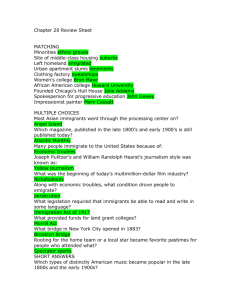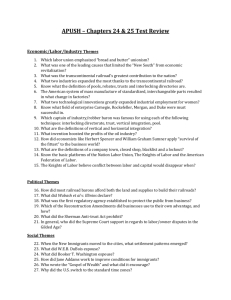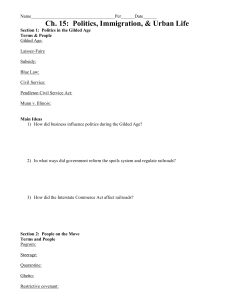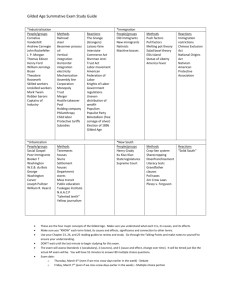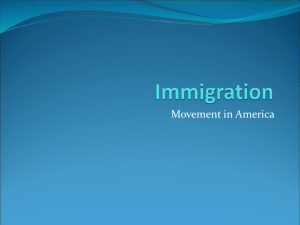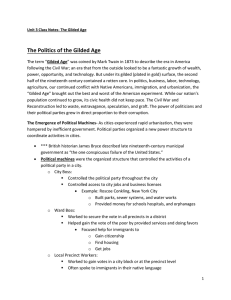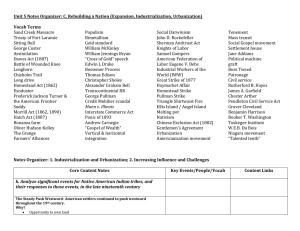File - Rhees US History
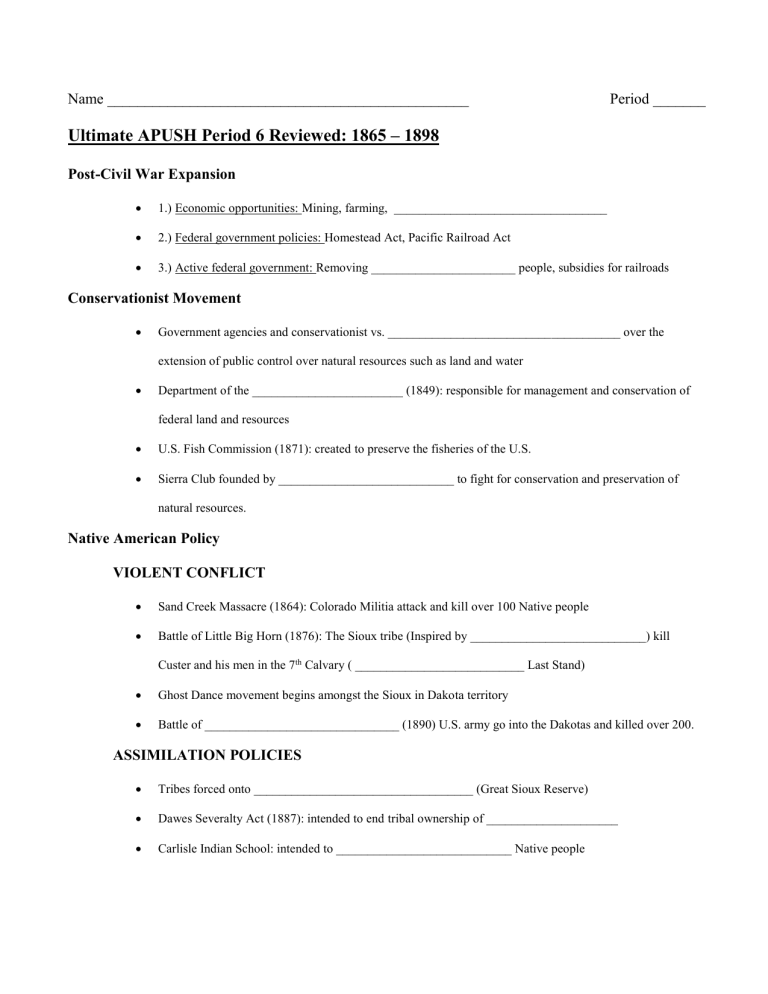
Name ________________________________________________
Ultimate APUSH Period 6 Reviewed: 1865 – 1898
Post-Civil War Expansion
Period _______
1.) Economic opportunities: Mining, farming, __________________________________
2.) Federal government policies: Homestead Act, Pacific Railroad Act
3.) Active federal government: Removing _______________________ people, subsidies for railroads
Conservationist Movement
Government agencies and conservationist vs. _____________________________________ over the extension of public control over natural resources such as land and water
Department of the ________________________ (1849): responsible for management and conservation of federal land and resources
U.S. Fish Commission (1871): created to preserve the fisheries of the U.S.
Sierra Club founded by ____________________________ to fight for conservation and preservation of natural resources.
Native American Policy
VIOLENT CONFLICT
Sand Creek Massacre (1864): Colorado Militia attack and kill over 100 Native people
Battle of Little Big Horn (1876): The Sioux tribe (Inspired by ____________________________) kill
Custer and his men in the 7 th Calvary ( ___________________________ Last Stand)
Ghost Dance movement begins amongst the Sioux in Dakota territory
Battle of _______________________________ (1890) U.S. army go into the Dakotas and killed over 200.
ASSIMILATION POLICIES
Tribes forced onto ___________________________________ (Great Sioux Reserve)
Dawes Severalty Act (1887): intended to end tribal ownership of _____________________
Carlisle Indian School: intended to ____________________________ Native people
Industrialization
_______________________ scale production
Tremendous _____________________________________ change
Improved communication networks
Business seeking to maximize the exploitation of a growing labor force and natural resources
Industry leaders such as Carnegie (_________________) and Rockefeller (___________) sought to dominate their respective industries through a variety of techniques:
____________________________ integration: Controlling all competition in a particular industry.
Consolidating all competitors to monopolize a market.
Vertical integration – Control all aspects of manufacturing from extracting raw materials to selling the finished product.
In order to eliminate or reduce competition business leaders sought to establish ______________________, trusts, and pools.
Business leaders defended their wealth with ideas such as _______________________________
Advocated for ____________________________________ policies
Regional Differences: “The New South”
There was an attempt at industrializing the southern economy
Increase in the number of __________________________ factories
The South remained dependent on agriculture o Tenant farming and _________________________________ continued to be the predominant labor system of the southern economy
Especially African Americans laborers in post Reconstruction South
Industrial Revolution
Industrialization and ________________________________ brought new economic opportunities for immigrants and workers
New career opportunities developed (in spite of social prejudice) for African Americans and ____________
While industrialization brought numerous opportunities to workers and dramatically expanded the work force, low wages and dangerous working conditions continued to be a problem.
WORKERS ORGANIZE
____________________________________ (1869) o Terrence Powderly opened the union to all workers (skilled & unskilled workers; women & African
Americans) o Declined following _____________________________ Riot in 1886
American Federation of Labor (1886) o Under the leadership of Samuel Gompers focused on __________________________ workers o Focused on “bread & butter” issues – wages, working conditions o By 1900 it was the _______________________ union
Evaluating the Labor Movement
SUCCESSES
Workers did form local and national unions that did directly confront power
Beginning of a national labor union movement and rise of union leadership ( Eugene Debs, Mother Jones)
FAILURES
Homestead Strike (1892): Workers at Carnegie’s _______________ plant defeated
_________________________ Strike (1894): President Cleveland uses the army and court injunction to defeat the strike.
Divisions between skilled vs. unskilled workers, ethnic and racial groups
_______________________ from corporations, no protection by government
The lives of farmers was also changing as they had to adapt to mechanized agriculture and dependence on powerful railroad companies.
* Problems for farmers: 1) Falling prices 2) unfair railroad business practices 3) high cost of machinery 4) tight money supply 5) ______________________________
Farmers Organize:
The __________________ Movement: organized social and educational activities. o Lobbied state legislatures for reforms
Farmers Alliance: Founded in Texas (1870s) – excluded blacks (Colored Farmers Alliance), ignored tenant farmers
Significant 3 rd Party: __________________________________ o
Platform: 1) Government ownership of railroads 2) free & unlimited coinage of silver (increase
$$$ supply) 3) graduated income tax (_____________ pay more) 4) direct election of Senators
5) use of initiatives and referendums
Government Intervention
Mark Twain called the era the “________________________” o Below the surface things are not as good as they seem
Politics during the Gilded Age was tied to big ___________________
___________________________ philosophy prevented the government from actively regulating the economy
Start of Government Regulation
Grange Movement: Munn v. Illinois ruled that ____________________ could regulate railroads
Wabash Case (1886) states CANNOT regulate ___________________________ commerce o Leads to passage of Interstate Commerce Act (1887)
Sherman Anti-Trust Act: Outlawed trusts & other _____________________that fix prices & restrained trade o Used against labor unions
The Movement of People
Large scale internal and external migration takes place
INTERNAL: o Settlers seeking opportunities on the ___________________ (available as a result of the
Homestead Act and completion of the transcontinental railroad) head ___________ o Mass movement of people to _______________ areas o African Americans moving out of the South into northern cities (“_________________________”)
EXTERNAL: o Large scale immigration from _______________ (Chinese Exclusion Act 1883 will change this) o Post 1880 – “new immigrants” from southern and ______________________ Europe (Russia,
Italy, Poland, etc.)
Largely settle in urban areas
Response to Changing Immigration
As a result of these new immigrants there was a rise in ________________________
Attempts to exclude: o ______________________ Exclusion Act (1882) o American Protective Association = anti-Catholic group made up of American Protestants o
__________________________ Test proposed to keep southern and eastern European immigrants out
Challenges of Urbanization & Immigration
Cities were often divided among classes, _______________________, ethnicities, and cultures
Low wages and dangerous working conditions kept many workers in extreme _______________________ o Contrast between the poor and the wealthy who enjoyed lives of “conspicuous consumption” o
_________________________ housing was common (documented by Jacob Riis “How the Other
Half Lives”)
_____________________ labor increasingly became a problem
Immigrants attempted to both assimilate (i.e. learn English) and maintain their own unique cultural identities
______________________ machines dominated city life by exchanging welfare services and jobs for
__________________________ support
Addressing the Challenges of the Gilded Age
Gospel of Wealth: Belief that the ____________________ had a moral obligation to help out those less fortunate o Andrew Carnegie “Wealth”
Settlement House movement sought to relieve urban poverty and provide assistance to immigrants o ________________________________ Hull House in Chicago
_______________________ Gospel movement challenged the dominant corporate ethic
_______________________ Party and other organizations challenged capitalism o Edward Bellamy “Looking Backward” about a utopian socialist society that has fixed the social and economic injustices of the time
Effort to reform these problems will eventually lead to a movement known as the _____________________
Movement in the 1890s
Addressing the Social Challenges of the Gilded Age
National American Woman Suffrage Association (NAWSA) sought to secure the right to vote for women
(suffrage) o Elizabeth Cady Stanton, Carrie Chapman Catt
Various African American leaders sought to advance the cause of __________________________ o Booker T. Washington: African Americans should acquire ___________________________ skills to gain self-respect and economic security
Established Tuskegee Institute o
Idea Wells-Barnett: active in women’s rights movement and in the campaign against
______________________________
